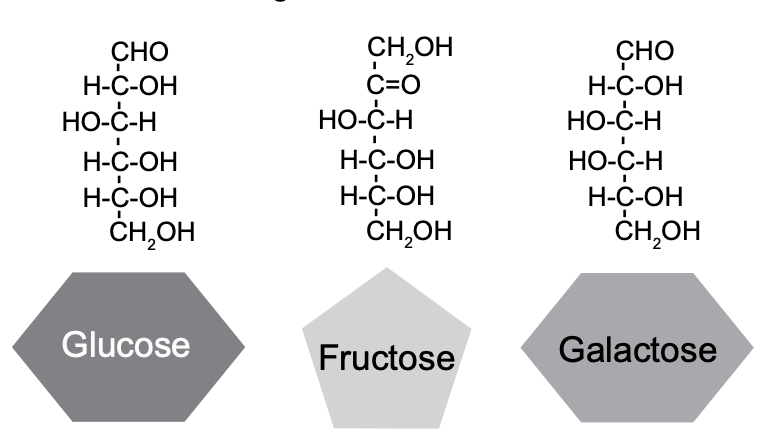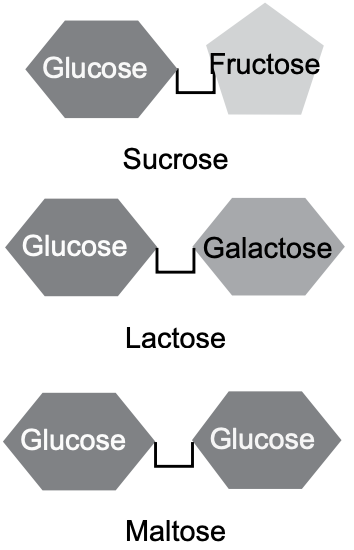4.3: Sugar Sweet
- Page ID
- 56182
Sugar is the basic unit of carbohydrates. On the tongue, most sugars are immediately perceived as sweet. Some biologists speculate that sweetness is almost always perceived as pleasant because sweetness is the hallmark of carbohydrate. And a mix of carbohydrate-rich foods—fruits, vegetables, grains—form the core of nutritious diets throughout the world.
Not all sweeteners are sugars. Aspartame (the sweetener in Equal and NutraSweet), for example, is a laboratory-made sweetener made up of amino acids (the basic component of protein). It is two amino acids (phenylalanine and aspartic acid) linked together, with the caloric value of protein (4 cal/gm). It’s a low-calorie sweetener because so little is needed for sweetening—it’s about 180 times sweeter than table sugar (see Table 4-1).
| 10,000 | Neotame |
| 800 | Sucralose (Splenda) |
| 500 | Saccharin |
| 200 | Acesulfame-K (Sunette, Sweet One) |
| 180 | Aspartame (NutraSweet, Equal) |
| 100 | Cyclamate |
| 30 | Tryptophan (an amino acid) |
| 1.7 | Fructose (sugar) |
| 1.0 | Sucrose ("table sugar") |
| 0.7 | Glucose (sugar) |
| 0.5 | Mannitol, sorbitol, inositol (sugar alcohols) |
| 0.3 | Maltose, lactose, galactose (sugars) |
| 0 | Starch |
Table 4-1: Approximate Relative Sweetness of Some Sweeteners
Saccharin, Acesulfame-K, and cyclamate are also non-carbohydrate lab-made sweeteners. They are non-caloric: Although they are absorbed from the intestine, they can’t be metabolized to produce energy, and are excreted in our urine.
Single Sugars
The simplest sugars are called single sugars (monosaccharides). Those most common in food are glucose, fructose, and galactose. All three of these sugars have 6 carbons, 12 hydrogens, and 6 oxygens, but differently arranged (see Fig. 4-2).
Glucose (also called dextrose) is the most common single sugar. Glucose is also a component of the double sugars sucrose, lactose, and maltose (Fig. 4-3) and is the repetitive unit in starch, glycogen, and cellulose.
Fructose is about twice as sweet as glucose and is found naturally in such foods as honey and fruit. High-fructose corn syrup is commonly used to sweeten food products. It’s much less expensive than sugar extracted from natural sources like sugar cane, and much sweeter than glucose or sucrose, so less is needed to sweeten a product. This markedly lowers a food company’s cost of a product when high-fructose corn syrup is the main ingredient—as in non-diet soft drinks.
High-fructose corn syrup is half glucose and half fructose (see Fig. 4-7), as is sucrose (table sugar) and honey, so there isn’t any metabolic basis for it being “worse” than honey or regular sugar. Its main “problem” as a sweetener is that it’s inexpensive. Would we buy that Big Gulp® 32-oz (1 quart) or Double Big Gulp® 64-oz (half-gallon) “cup” of a soft drink if it weren’t so cheap and if it didn’t taste so good?

Galactose is found mainly as a part of “milk sugar” (lactose, a double sugar) and isn’t very sweet —about half as sweet as glucose. While we won’t make deep forays into organic chemistry here, let’s look a bit at the construction of these sugars—just to see the pattern by which Nature weaves the same few components into very different substances, each with its own special role.
Glucose, fructose, and galactose are all 6-carbon sugars—they’re made up of six hydrated carbons. But these simple sugars aren’t the smallest ones. There are some with only three carbon atoms and some with five.
Characteristically, the smaller sugars often appear as indispensable parts of some of the most complex chemicals of life. Consider the 5-carbon sugar called ribose. It’s from this that the B-vitamin riboflavin takes its name. From ribose also come the names of the key chemicals of genetics, RNA and DNA—ribonucleic acid and deoxyribonucleic acid.
Ribose, important as it is, doesn’t have to be consumed in foods. The body can make it from other carbohydrates. This suggests two principles that are contrary to popular belief:
- It isn’t true that carbohydrates serve only the purpose of supplying energy. Although they aren’t essential in the diet, carbohydrates also supply some of the important building blocks of life.
- A substance that‘s essential in the body—such as ribose (and cholesterol as well)—isn’t necessarily essential in the diet. In fact, one might expect that the body, in its wisdom, would make its most essential substances rather than rely on dietary habits to provide a supply.

Double Sugars
The double sugars (disaccharides) are two single sugars linked together (see Fig. 4-3). Glucose and fructose—two single sugars that are common in the plant world—are very often combined. When one of each joins the other, we get sucrose (glucose + fructose)—common table sugar.
Table sugar is sucrose, a double sugar made of glucose and fructose.
It’s hard to find a sweet-tasting fruit or vegetable that doesn’t contain at least a little sucrose. And often there’s more sucrose than either glucose or fructose alone. This is certainly the case of the sweet wild plant called sugar cane. Its sap runs rich with sucrose. Refining sugar is simply a matter of separating this sugar from the rest of the plant, which is almost entirely indigestible, as anyone knows who has chewed a stalk. (The same is true for the abundant sucrose in the sugar beet.)
The other most common double sugars found in our food are lactose and maltose. Lactose (glucose + galactose) is the sugar in milk and is the only carbohydrate of animal origin that is consumed in significant quantities. Maltose (glucose + glucose) is the breakdown product of starch, and is the “malt” in malted milk and in the malted barley used to make beer.


